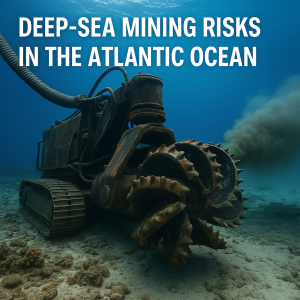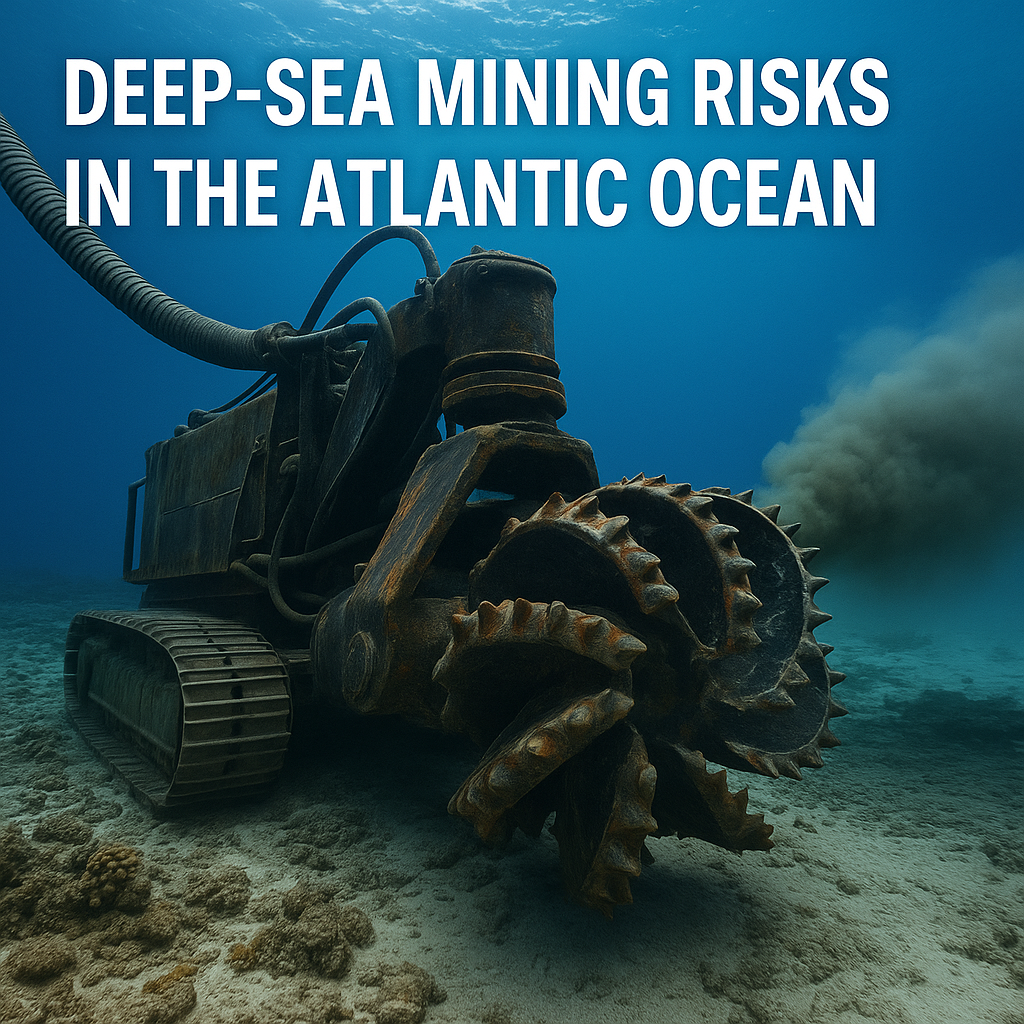Discover the environmental and geopolitical risks of deep-sea mining in the Atlantic Ocean. This in-depth article explores ecological impacts, international legal frameworks, stakeholder concerns, and the technologies driving this controversial frontier in maritime exploration.
Why Deep-Sea Mining in the Atlantic Matters Today
 The Atlantic Ocean, long revered for its rich maritime history and trade routes, is now facing a new frontier: deep-sea mining. As the global demand for critical minerals like cobalt, nickel, and rare earth elements intensifies, eyes are turning to the seabed — particularly in the mid-Atlantic Ridge and surrounding abyssal plains. These areas are rich in polymetallic nodules and sulfide deposits, containing materials essential for electric vehicles, renewable energy infrastructure, and high-tech industries.
The Atlantic Ocean, long revered for its rich maritime history and trade routes, is now facing a new frontier: deep-sea mining. As the global demand for critical minerals like cobalt, nickel, and rare earth elements intensifies, eyes are turning to the seabed — particularly in the mid-Atlantic Ridge and surrounding abyssal plains. These areas are rich in polymetallic nodules and sulfide deposits, containing materials essential for electric vehicles, renewable energy infrastructure, and high-tech industries.
But beneath the allure of economic opportunity lies a wave of ecological, regulatory, and ethical risks. Deep-sea mining has the potential to alter fragile ecosystems that have taken millions of years to evolve. For maritime professionals, governments, and environmental stakeholders, understanding the full scope of deep-sea mining risks in the Atlantic is not only necessary — it is urgent.
What Is Deep-Sea Mining and Where Is It Happening in the Atlantic?
Deep-sea mining refers to the extraction of minerals from the ocean floor, often at depths exceeding 3,000 meters. In the Atlantic, key areas of interest include:
- The Mid-Atlantic Ridge, known for its hydrothermal vents and polymetallic sulfide deposits
- The Clarion-Clipperton Zone (CCZ) to the west (though primarily in the Pacific, its edge connects to Atlantic zones of strategic interest)
- Areas within Exclusive Economic Zones (EEZs) of countries like Brazil, Portugal (Azores), and West African nations such as Sierra Leone and Ghana
According to Marine Policy (Elsevier, 2024), more than 17 exploratory licenses have been granted in Atlantic-adjacent waters by national and international agencies, including through the International Seabed Authority (ISA) under the United Nations Convention on the Law of the Sea (UNCLOS).
Key Technologies Driving the Deep-Sea Mining Frontier
Modern deep-sea mining relies on a hybrid of offshore oil and gas drilling technology and subsea robotics. Recent developments include:
- Remotely Operated Vehicles (ROVs) and Autonomous Underwater Vehicles (AUVs) capable of navigating hostile seabed terrains
- Hydraulic suction dredgers and mechanical cutters that extract and transport mineral-rich mud to the surface
- Real-time monitoring systems developed by firms like Wärtsilä and Fugro to track plume dispersion and equipment performance
A 2023 report by DNV emphasized that while technology has improved reliability, environmental predictability remains low due to insufficient long-term data.
Environmental Risks: What’s at Stake Beneath the Waves?
The deep Atlantic is home to unique ecosystems — from bioluminescent fish and deep-sea corals to hydrothermal vent communities that exist nowhere else on Earth. Mining operations risk:
- Habitat destruction: Mechanical disruption of the seabed can destroy fragile biomes that have evolved over millennia.
- Sediment plumes: Mining stirs up fine particles, potentially smothering nearby habitats and disrupting filter feeders.
- Noise pollution: Subsea mining generates low-frequency noise harmful to marine mammals and fish communication.
The Marine Pollution Bulletin (2023) warns that recovery rates in the deep ocean are incredibly slow. A single disturbed site may take 50 to 100 years — or more — to show signs of regrowth.
Regulatory Frameworks: Are They Keeping Up?
The legal landscape of deep-sea mining is complex and, in some areas, lagging behind technological progress. Here’s what governs Atlantic deep-sea mining:
- UNCLOS: Designates international seabed areas as the “common heritage of mankind.”
- International Seabed Authority (ISA): Oversees mineral-related activities in international waters, including licensing and environmental standards.
- Regional Seas Conventions: Such as OSPAR, which aims to protect the North-East Atlantic marine environment
- National EEZ Laws: Countries like Brazil and Portugal are drafting tighter environmental impact assessment (EIA) laws for deep-sea operations
A 2022 analysis by the World Ocean Review and WMU Journal of Maritime Affairs highlighted that ISA regulations on environmental thresholds are still considered vague, with no mandatory halt mechanisms if ecosystems face irreversible harm.
Case Study: Portugal’s Azores and the Mid-Atlantic Ridge
The Azores, a Portuguese archipelago situated along the Mid-Atlantic Ridge, have become a focal point for both mining interest and conservation.
In 2023, Portugal issued a moratorium on deep-sea mining in its EEZ pending further ecological impact studies. At the same time, the Azores hosted the Atlantic Deep Ocean Symposium supported by UNESCO and the Royal Institution of Naval Architects (RINA), promoting marine research and biodiversity mapping.
This balanced approach showcases the struggle between national resource exploitation and global environmental stewardship.
Case Study: The African Continental Margin
West African countries such as Ghana and Sierra Leone have begun assessing the economic potential of Atlantic seafloor resources. However, these efforts are shadowed by concerns over institutional capacity, marine data infrastructure, and coastal livelihood disruption.
According to UNCTAD (2024), local fisheries in Ghana contribute to more than 50% of the country’s animal protein intake. Sediment plumes from deep-sea operations could drastically alter fish migration and spawning patterns, jeopardizing food security.
Socioeconomic Concerns: Who Wins, Who Loses?
Deep-sea mining is often marketed as a solution to supply chain fragility and green energy demand. However, critics argue that benefits will likely be concentrated among a few multinational mining corporations and tech producers.
In contrast, risks — including environmental degradation and loss of fisheries — are disproportionately borne by coastal communities in the Global South. Indigenous and local stakeholders often lack formal representation in ISA deliberations, raising questions of equity and consent.
The Shipping Industry’s Role and Risks
Deep-sea mining will likely increase maritime traffic, particularly for specialized mining support vessels (MSVs) and bulk carriers transporting extracted materials.
This raises several concerns:
- Navigational hazards from operating in uncharted deep-sea zones
- Marine insurance complexities for deep-sea cargo, currently under-assessed by P&I clubs
- Greenhouse gas emissions from mining fleets, potentially offsetting sustainability gains from mineral use
BIMCO and the International Association of Classification Societies (IACS) have begun reviewing draft guidelines for class certification of sub-sea mining support vessels, but adoption remains nascent.
Future Outlook: Is a Moratorium the Only Ethical Path?
Over 20 countries — including France, Germany, and several Pacific Island nations — have called for a moratorium on deep-sea mining until robust environmental standards are enacted. A resolution backed by the International Maritime Organization (IMO) and the European Commission is under review for implementation across Atlantic territories.
On the other hand, proponents argue that delaying mining will delay green energy transitions and perpetuate dependence on conflict minerals from terrestrial sources.
A balanced path forward may lie in:
- Expanding marine protected areas (MPAs) in the Atlantic
- Funding long-term baseline ecological studies
- Mandating open-source data sharing from mining trials
FAQ: Deep-Sea Mining in the Atlantic
1. What is the main purpose of deep-sea mining?
To extract valuable minerals such as cobalt, nickel, and rare earth elements used in electronics and renewable energy technology.
2. Is any deep-sea mining currently happening in the Atlantic?
Only exploration is occurring as of 2025, but multiple licensing applications are under review.
3. How deep are these mining operations?
Most occur between 3,000 and 6,000 meters below the ocean surface.
4. Who regulates deep-sea mining?
Primarily the International Seabed Authority (ISA) under UNCLOS, along with national agencies.
5. What are the biggest risks?
Irreversible ecosystem damage, fisheries disruption, sediment plumes, and regulatory gaps.
6. Are there any successful case studies?
No large-scale operations have yet been deemed environmentally sustainable or economically viable in the Atlantic.
7. Can the shipping industry be impacted?
Yes, through increased vessel traffic, insurance risks, and environmental scrutiny.
Conclusion: A Sea of Caution Ahead
Deep-sea mining in the Atlantic is a rapidly evolving issue at the intersection of technology, geopolitics, and environmental ethics. While it promises access to valuable resources, it also threatens ecosystems we barely understand. For maritime stakeholders, staying informed and engaged in global governance discussions is vital.
Before diving headlong into the depths, the world must weigh the true cost of what lies beneath. After all, the ocean is not just a resource bank — it’s a living, breathing system on which all life depends.
References
- International Seabed Authority (ISA): https://www.isa.org.jm/
- Marine Pollution Bulletin (Elsevier): https://www.sciencedirect.com/journal/marine-pollution-bulletin
- World Ocean Review (2023): https://worldoceanreview.com
- UNCTAD Review of Maritime Transport (2024): https://unctad.org/topic/transport-and-trade-logistics/review-of-maritime-transport
- WMU Journal of Maritime Affairs: https://link.springer.com/journal/13437
- DNV Deep-Sea Technology Outlook (2023): https://www.dnv.com
- RINA Technical Papers – Deep Ocean Symposium Proceedings
- IMO Guidelines for Subsea Activity (Draft): https://www.imo.org
- BIMCO Environment and Vessel Safety Reports: https://www.bimco.org
- MarineTraffic Mining Vessel Tracker: https://www.marinetraffic.com

